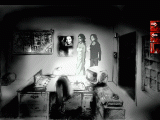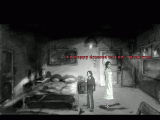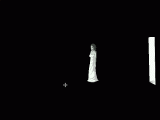At this point, most of you have probably had the chance to familiarize yourselves with Remigiusz Michalski’s odd-one-out horror adventure Downfall, so instead of simply laying down our impressions in anticipation of a full review, I’m jotting down my two cents on both the new and the old Downfall demo.
I’d also like to attempt to propose the answer to two questions: First, do either manage to capture your interest? Second, do the demos succeed in their utilization of demonstrative methodology? Difficult questions that I hope to address in my post. Read on, and check out some more comparative screenshots after the jump!
Earlier, we established that the game is set around the ominous Quiet Haven Hotel, where Joe and Lucy Davis take shelter overnight. Over the course of the new 2009 demo, however, the player is positioned in the shoes of Agnes, another visitor at the eerie hotel. Agnes, having run away and fallen asleep in her room, dreams “…a strange dream that soon turns into her worst nightmare.”1
Enter “Scandinavian rock god” Vilde Veihlo, Agnes’ favourite star. This ghost-like, floating rocker guides Agnes with a series of obscure clues, and Agnes, smitten with her dreamy idol, obliges with great gusto, at times worrying how she’s portraying herself in his presence. As difficult as it is to grasp the full implications of her actions in the demo, it remains clear that she is fulfilling some sort of predetermined role in the finer fabric of events transpiring in the area.
Mind you, both Agnes and her dream seem perfectly ludicrous at first: She tends to act rather childishly, and remains calm and unperturbed even when she finds herself locked in her room - all too willing to embrace the quite horrific conditions (a fresh grave right beneath her window!) and implications laid out in her dream-state.
With neither Agnes nor Veihlo – or anything else, for that matter - established when actual gameplay begins, it first felt as though a lack of surface might end up being the demo’s ultimate downfall. But having completed the demo, I begun to realize how it was not so important that either character be there, but be there together, acting out their roles; Secondly, whoever her dream guide really is (whether it is Agnes’ own consciousness, or someone else’s) seemed to know how to best lure Agnes into fulfilling her task, as Veihlo is suited for the mere fact that she is so taken by him. It’s made clear that she objectifies and sexualizes Veihlo, even when she thinks he’s dead.
Overall, the demo’s short narrative remains schizophrenic, jagged and violent – ultimately enticing, but also hard to take at face value without better knowledge.
Now, this finally leads us up to my second question, relating to the nature of the demonstration at work: I truly came to wonder whether it’s a) fair or b) useful to present such a splintered facet of the game as a demo? I am very much intrigued by the situation, but remain uncertain whether this is because I know very little more than I did before I started, or because the game is truly that interesting?
This profoundly relates to the relationship of absence and presence of information in the game’s narrative, and to conclude, I have no answer - not without playing the game fully first. The bottom line is that where the trailer seemed utterly focused on its machinegun-like slideshow of horror, the demo begins with a surprisingly meditative and verbose pace, offering little hint of what may come. This leads me to think there may be sudden versatility to the game.
Secondly, the game’s official website presents to us a far broader array of locations, characters and situations not touched in any manner or degree in the demo, and as the game has several playable characters, it remains to be seen whether Agnes has a fleshed-out role in the game, or whether she’s more of a bait designed for the demo. Overall, the demo does remind me of Yahtzee’s Chzo Mythos series, especially its last two parts, Trilby’s Notes and 6 Days a Sacrifice. This is as strong a recommendation as any.
Against this backdrop, the old demo is somewhat relegated to a footnote, and Michalski is probably not very pleased that I should bring it up anyway; still, it’s very hard not to feel some intrigue with the possibility of analyzing and comparing old and new material from the production cycle, for the sake of science…
That being said, the Downfall demo of 2007 opens up in a completely different manner: The apparent (…after the new demo, I’m not so sure any more…) main character of the game, Joe, is being interrogated by an anonymous police officer, and it appears he has been taken in for manslaughter.
Joe then proceeds to narrate his side of the story over some quite startling imagery that manages to touch, over the period of a few minutes, eating disorder, child abuse, involuntary imprisonment, insanity and cannibalism – quite a change of pace, both with the clarity of narration and with its delivery. The actual gameplay of the demo only lasts for a fleeting moment, but does quite perversely raise the question of how much is it even necessary to have gameplay in a demo, if it’s primary function - to develop interest - is attained?
Ultimately, I was left wondering whether the old demo could be considered somewhat of a spoiler, or whether the two games (are they somehow separate? What, if anything, changed during the game’s progress from a demo to a full-fledged release?) are even that related to each other; only a play-through will tell!
- http://prawkonj.republika.pl/harvest/games_downfall.html [↩]










[…] As we are indeed discussing a game of the ‘horror’ genre – whatever that is in the adventure context – something must be said of its fear factor! Outwardly, the game seems based on bloodshed (see release trailer), but in playing the game, it becomes evident that beyond the gore, Michalski ultimately aimed for anxiety and suspense akin to that of the original Gabriel Knight - Sins of the Fathers. Remember its final crescendo? Downfall’s multiple, branched-out finales are something to behold in similar manner. Additionally, Michalski’s use of intermittent verbal and non-verbal humour is also parallel to Jensen’s: Banal banter and off-beat absurdity sometimes break down the otherwise overbearing ambience. This is especially true of Agnes’ segment. More of that in my demo review. […]